Spoiler-free
As hooks tear flesh and blood flows red, I sit back and enjoy the pain. It’s as if I can feel the hooks pierce my skin and pull me apart, and I’ve never felt better.
I’m watching Clive Barker’s Hellraiser (1987) and I couldn’t be more enthralled. It’s the sort of gory genre master-work that I’ve made my bread and butter. In other words, it’s extremely my style. For both the film and the original short story it’s based on, writer and director Clive Barker drew on his own experiences as a gay man in the BDSM scene, imbuing Hellraiser with a level of queerness and raw sexuality that really serves as the theatrical underpinning which holds the entire story together. It’s a story about pleasure and pain, the length’s one will go to to experience either and the dangers of giving in to our own vices. In every torn piece of flesh, every bludgeoned suitor and every sexual encounter, you can feel these thematic pulls, making Hellraiser so much more than your average gory horror flick. However, the Hellraiser franchise has famously been one of diminishing returns and, despite the enjoyability of Hellbound: Hellraiser 2 (1988), for which Peter Atkins and Tony Randel took the reigns as writer and director respectively, much of what makes the original such a stunning work is lost in the sequels, resulting in one of the most disappointingly flaccid horror franchises out there.
When I first heard that Jamie Clayton had been cast as Cenobite Hell Priest Pinhead in David Bruckner’s reboot of the Hellraiser franchise (simply titled Hellraiser, same as the original), I was deeply excited. The casting of a trans woman as the series’ most iconic villain signalled a return to Hellraiser’s queer roots and, hopefully, a return to the thematic interests which made the original so, well, interesting. The film we received in the end, however, is not what I had hoped.
Hellraiser (2022) is an admirable effort. Bruckner clearly has an understanding of the queerness of the original film and enough of a grasp on horror filmmaking to craft a fairly competent film. It’s poorly lit (though near every film is nowadays, film lighting as an art form basically dead) and suffers from pacing issues (more on that later), but all in all it’s a well-made, fairly enjoyable film. The gore in particular is a strong point; any moment where Bruckner indulges the audience with something nasty and visceral, there are glimpses of feeling reminiscent of the first time seeing the signature Hellraiser hooks in the original. The Cenobite designs are also fantastic, just really cool make-up design work.
The film falls apart, however, in its complete and utter sexlessness. Despite the opening scene with our protagonist being a sex scene, the rest of the film is completely devoid of the sexuality which the original film oozes and thrives upon. In its place is a subplot about drug addiction which, while an interesting direction to take the franchise, is underbaked and largely falls flat. As a result, the talk from the Cenobites and hedonistic human villain Voight of pleasures unknown to man feels hollow, unsupported by anything we’re shown in the film. It’s disappointing, because the resulting effect is that the queerness of the film’s cast and characters ends up feeling superficial and neutered. The original film is about queer sexuality, when you take away the sexuality and don’t put anything else fitting in its place, you just about lose the queerness altogether. Which is disappointing because clearly the people involved in making this film really care about it as a defining aspect.
Furthermore, as mentioned, the film really does suffer from some serious pacing issues. Whereas the original constantly moves forward, culminating in a thrilling, terrifying, balls to the wall orgy of violence and death, a whirlwind climax almost unmatched in all of horror, Bruckner’s Hellraiser drags its feet through its entire 120 minute runtime. Bruckner does attempt a similar climactic hurrah, except this one is dragged out for 45 minutes, marred by lengthy exposition of lore which I imagine was from one of the many sequel films or books I skipped before seeing this one but is, frankly, unnecessary. All you really need to make Hellraiser work is a funky box and some BDSM sex demons. I’m unsure as to why the box needed several configurations and convoluted bargains this time around. If you made this film 30 mins shorter, cutting out all the fluff and condensing what’s here to a tight 90 minutes, it would make for a much more effective film.
Altogether, I’m not completely turned off by this film. There’s a lot to love here and I certainly enjoyed watching it, but it lacks the guts that hold the original Hellraiser together. Sex and violence, pleasure and pain, queer sexuality and torn flesh, these are the things that make Hellraiser tick and they simply aren’t present enough.
I feel no pleasure, I feel no pain, all I feel is emptiness.
Hellraiser (2022) can be seen on Binge in Australia now. Hellraiser (1987) can currently be watched on Amazon Prime Video, or rented through a variety of other services.

